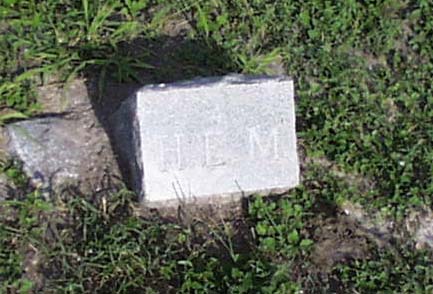Harriet Eliza Moore
Place of Birth: New York State
Age of Death: 84
Date of Death: November 22, 1899
Interment source:
Bay View Cemetery Association, Corpus Christi, Texas. Record of Interments

Photo Credit: Rosa G. Gonzales
1. Photograph
Provenance: Larry Rettinger and Deanna Rathke
Provenance: Larry Rettinger
3. Biography
Harriette Eliza Moore was born in Johnstown, New York on October 25, 1815 according to the family records. She was the daughter of M. C. Conklin who was partner to John Marks Davenport Moore (1811-1892) in a coal venture. Mr. Moore married his partner's daughter Harriette in 1837 (Handbook of Texas). Harriette was by her husband's side as he served in the Alabama legislature for two terms. In 1855 he became president of the Alabama Coal and Mining Company which introduced the couple to Corpus Christi as the company provided the first steam dredge for the work on the Corpus Christi ship channel in 1858. Because of severe financial reverses John and Harriette had to liquidate most of their Alabama holdings and consolidate assets in Corpus Christi where they settled. After the Civil War, Harriette's husband continued to be involved in the port of Corpus Christi as he purchased outstanding bonds and share of the Corpus Christi Ship channel from John W. Vineyard through the help of his relative, George E. Conklin. Harriette would have been "First Lady" of Corpus Christi from October 1877 to 1880 while her husband served as mayor of the city. He died on August 20, 1892, and Harriette died on March 22, 1895. She was buried with her husband, brother, and other family members in Old Bayview Cemetery.
Research and transcription: Michael A. Howell
4. Obituary
MOORE—Harriette E. Moore was born October 20, 1814, in Johnstown, New York and died in Corpus Christi, Texas, March 22, 1899. Her grandfathers were both officers in the Revolutionary Army, and for several generations the family had been Presbyterian, which Church she joined at fourteen years of age. From her mother she received training in practical Christianity, which told throughout her long life. She was married to Col. John M. Moore in 1837, in Marion, Ala. After which she joined the Methodist Church with her husband, and at their home God's ministers, regardless of denomination, received a warm welcome. The (sic) most of her children were made life members of the American Bible Society and taught to distribute the Bible among the poor. Both Bro. and Sister Moore stood high in Masonry and were eminently useful in the Church. A sweeter face was never seen than the one we laid away in the silent tomb that day. It was the very outshining of a beautiful, consecrated Christian life, and as we sang, "The Sweet By-and-By," standing beside the grave, we felt that one more saint had crossed the river and that we should see her again. She did not die; she simply folded her hands and went to sleep.J. M. Linn, Corpus Christi, Texas.
Copy in Moore papers in Archives of Corpus Christi Public (Central) Library
Research and transcription: Michael A. Howell
5. Footstone
Originally a tombstone was the stone lid of a stone coffin, or the coffin itself, and a gravestone was the stone slab that was laid over a grave. A headstone was a marker placed upright near the head of the coffin. Now usually all three terms are used for markers placed at the head of a grave. Beginning in the 1700s graves also might contain footstones to demarcate the foot end of the grave. Footstones were rarely carved, and they were small enough that most cemeteries removed them to make cutting the grass easier (see article from Wikipedia on gravestones). Footstones consequently are traditionally used only in conjunction with headstones and often (as in the case of Old Bayview Cemetery) bear only initials as inscriptions. The footstones in Old Bayview Cemetery are small flat cubes of this variety (bearing only initials). The identity of the person referred to in the footstone can only be deduced based on the initials given, the existence of the original headstone, and the presumption that the footstone is still in or close to its original site. Unfortunately there is no assurance that footstones have not been misplaced over the years. Consequently any identifying of the footstone's owner can only be a logical guess.